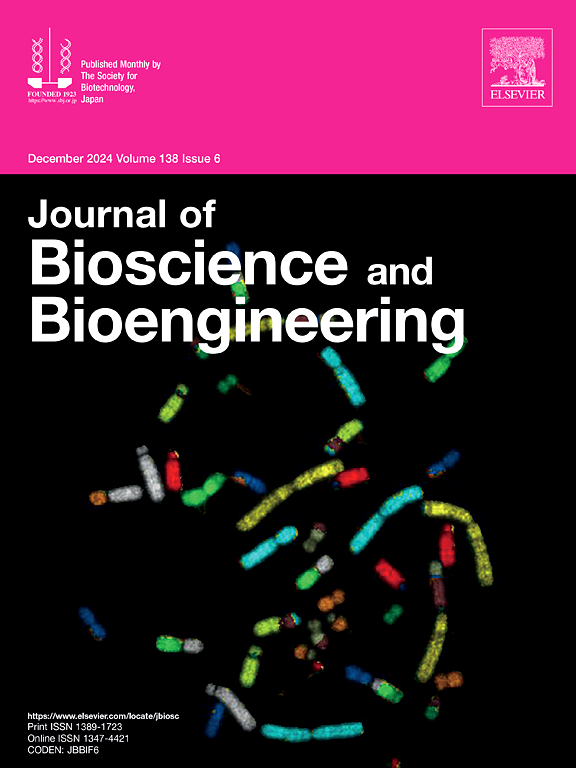Engineering anaerobic electron flow through heterologous rhodoquinone synthesis in model microbial and photosynthetic platforms
IF 2.9
4区 生物学
Q3 BIOTECHNOLOGY & APPLIED MICROBIOLOGY
引用次数: 0
Abstract
Anaerobic conditions facilitate bioproduction by enabling diverse metabolic pathways; however, they disrupt redox balance due to the accumulation of reduced cofactors, limiting metabolic efficiency. Rhodoquinone (RQ), a low-redox-potential quinone, supports electron transport under anaerobic conditions. Unlike menaquinone, RQ is synthesized from ubiquinone through a single enzymatic reaction catalyzed by rhodoquinone biosynthesis protein A (RquA), making it a simple, adaptable metabolic engineering tool. In this study, RQ was synthesized in the menaquinone-deficient Escherichia coli ΔmenA strain via heterologous gene expression of rquA from Euglena gracilis. The engineered strain tripled succinate production under anaerobic conditions compared with the control strain. Redox analysis showed a decreased NADH/NAD+ ratio, reflecting improved electron flow under oxygen-limited conditions. Introducing rquA into a strain with high succinate production further increased succinate yields, confirming compatibility with existing metabolic modifications. To explore broader applications, rquA from Rhodospirillum rubrum was expressed in Cyanidioschyzon merolae mitochondria using a construct with a C. merolae mitochondrial targeting signal. Quinone analysis confirmed RQ synthesis, and the engineered strains produced more succinate anaerobically relative to the controls. Although redox cofactor ratios in C. merolae remained stable, rotenone sensitivity indicated altered mitochondrial electron transport under anaerobic conditions. These findings demonstrate that RQ synthesis enhances anaerobic metabolism in bacterial and eukaryotic systems, providing a versatile tool for metabolic engineering under oxygen-limited conditions.
异源红醌在模式微生物和光合平台合成的工程厌氧电子流。
厌氧条件通过实现多种代谢途径促进生物生产;然而,由于减少的辅助因子的积累,它们破坏了氧化还原平衡,限制了代谢效率。Rhodoquinone (RQ)是一种低氧化还原电位的醌,在厌氧条件下支持电子传递。与甲基萘醌不同,RQ是由泛醌通过单一酶促反应合成的,由红醌生物合成蛋白a (RquA)催化,使其成为一种简单、适应性强的代谢工程工具。在本研究中,RQ是通过外源表达细叶草rquA基因在甲基萘醌缺乏的大肠杆菌ΔmenA菌株中合成的。与对照菌株相比,工程菌株在厌氧条件下的琥珀酸产量增加了两倍。氧化还原分析显示NADH/NAD+比值降低,反映了限氧条件下电子流的改善。将rquA引入高琥珀酸产量的菌株进一步提高了琥珀酸产量,证实了与现有代谢修饰的相容性。为了探索更广泛的应用,我们利用带有C. merolae线粒体靶向信号的构建体在红红螺旋菌线粒体中表达rquA。醌分析证实了RQ合成,并且工程菌株与对照相比厌氧产生更多的琥珀酸盐。尽管墨藻的氧化还原辅助因子比率保持稳定,但鱼藤酮敏感性表明在厌氧条件下线粒体电子传递发生了变化。这些发现表明,RQ合成增强了细菌和真核生物系统的厌氧代谢,为缺氧条件下的代谢工程提供了一种多功能工具。
本文章由计算机程序翻译,如有差异,请以英文原文为准。
求助全文
约1分钟内获得全文
求助全文
来源期刊

Journal of bioscience and bioengineering
生物-生物工程与应用微生物
CiteScore
5.90
自引率
3.60%
发文量
144
审稿时长
51 days
期刊介绍:
The Journal of Bioscience and Bioengineering is a research journal publishing original full-length research papers, reviews, and Letters to the Editor. The Journal is devoted to the advancement and dissemination of knowledge concerning fermentation technology, biochemical engineering, food technology and microbiology.
 求助内容:
求助内容: 应助结果提醒方式:
应助结果提醒方式:


